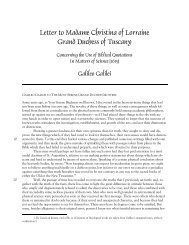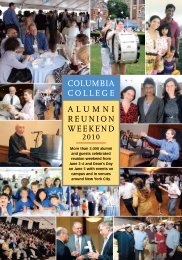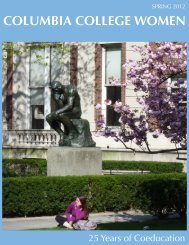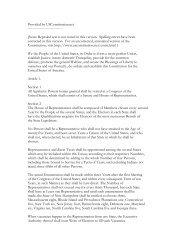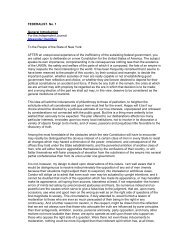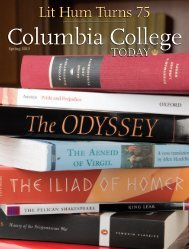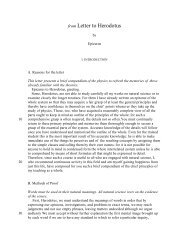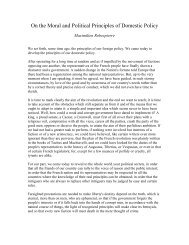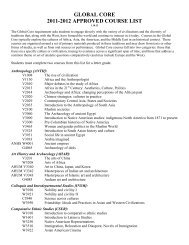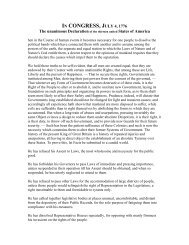Download this issue as a PDF - Columbia College - Columbia ...
Download this issue as a PDF - Columbia College - Columbia ...
Download this issue as a PDF - Columbia College - Columbia ...
You also want an ePaper? Increase the reach of your titles
YUMPU automatically turns print PDFs into web optimized ePapers that Google loves.
CLASS NOTES<br />
COLUMBIA COLLEGE TODAY<br />
COLUMBIA COLLEGE TODAY<br />
CLASS NOTES<br />
Bill Struning chimes in with <strong>this</strong><br />
note: “Will report on my activities<br />
(such <strong>as</strong> they are) at a later date.<br />
However, I wanted to express my<br />
thanks and appreciation to Henry<br />
Rolf Hecht for his many years <strong>as</strong><br />
CC ’44 cl<strong>as</strong>s correspondent. He<br />
did a great job of gathering and<br />
reporting on what must have been<br />
a relatively small member b<strong>as</strong>e<br />
(WWII did not help). CC ’44 w<strong>as</strong><br />
fortunate to have him representing<br />
us. We also were fortunate to enjoy<br />
the long-term services of Walter<br />
Wager in pre-Hecht years.”<br />
Henry Hecht (“proudly ’44”)<br />
responds <strong>as</strong> follows: “I’m doing<br />
OK, all things considered. Since being<br />
hit by some sudden weakness<br />
in February 2012, I have difficulty<br />
walking or concentrating while<br />
at my desk, but fortunately no<br />
pain and still re<strong>as</strong>onably alert. Not<br />
much more to report — family w<strong>as</strong><br />
planning a belated 90th birthday<br />
celebration for wife Hattie and me<br />
in May; we both turned 90 early<br />
<strong>this</strong> year. While I had to give up<br />
being cl<strong>as</strong>s correspondent, I would<br />
still love to hear from remaining<br />
friends at hrh15@columbia.edu.<br />
Best wishes to you all.”<br />
My old Yonkers H.S. buddy,<br />
Wilton Entwistle, tells us he prefers<br />
to be addressed <strong>as</strong> “Bill” and states:<br />
“Though I never graduated due<br />
to a call from the Army in ’42, the<br />
<strong>College</strong> h<strong>as</strong> followed me over these<br />
many years. My Army service took<br />
me to Europe in ’44 with the 95th<br />
Infantry Division, 377th Medical<br />
Battalion, and while we were in<br />
Germany I received a wound from<br />
a land mine that qualified me for a<br />
Purple Heart. I continued with the<br />
95th until the division w<strong>as</strong> brought<br />
back to the United States for the<br />
purpose of training for the war with<br />
Japan. But Harry Truman dropped<br />
a couple of A-bombs, and that war<br />
ended while we were still in the<br />
U.S.<br />
“My wife, Aurelia, and I were<br />
married in ’44, and we decided<br />
to move to California, where I<br />
worked with Occidental Life Insurance<br />
Co. (later a part of Transamerica<br />
Life) in its home office (not in<br />
sales) and remained with the company<br />
for 37 years, ending up <strong>as</strong> an<br />
<strong>as</strong>sociate v.p. before resigning at 62<br />
to enjoy retirement. Aurelia and I<br />
have traveled across a large part of<br />
the world but now live a quiet life<br />
in Laguna Woods, Calif., having<br />
resided here for 23 years. We have<br />
three children, six grandchildren<br />
and six great-grands to show for<br />
our production line. Aurelia and I<br />
celebrated 69 years of married life<br />
on March 6 and my 90th birthday<br />
came on March 15. I’m sure most<br />
of our gang is in the same age area<br />
that I am, and several have p<strong>as</strong>sed<br />
on. But all of us must face that<br />
eventuality. So, go with God, old<br />
friend. I send you my best wishes.<br />
With Robert Browning, I quote,<br />
‘Grow old along with me! The best<br />
is yet to be,/The l<strong>as</strong>t of life, for<br />
which the first w<strong>as</strong> made ...’”<br />
My Beta Sigma Rho fraternity<br />
brother Dick Farber writes, “After<br />
enough years of working in technical<br />
electronic activities, I retired<br />
and have been leading a ple<strong>as</strong>ant<br />
life. My wife and I have three children,<br />
seven grandchildren and, <strong>as</strong><br />
of a little less than two years ago,<br />
our first great-grandchild. We had<br />
the second wedding in the family<br />
earlier <strong>this</strong> month in Akumal,<br />
Mexico (about 1½ hours south of<br />
Cancun). We will have our third<br />
family wedding in June. My sons,<br />
Martin ’71 and Andrew ’75, and<br />
one grandson (Martin’s son Aaron<br />
’05, the one who just got married)<br />
went to <strong>Columbia</strong> and are doing<br />
well. My wife and I are slowing<br />
down in activities but what do you<br />
expect from older age Stay well.”<br />
Finally, we note with sadness<br />
the p<strong>as</strong>sing of Gordon Cotler,<br />
Robert A. Fishman, Richard Bader<br />
and Robert L. Rosenthal.<br />
45<br />
Enoch Callaway<br />
87 Barbaree Way<br />
Tiburon, CA 94920-2223<br />
enoch.callaway@ucsf.edu<br />
This will be my l<strong>as</strong>t set of Cl<strong>as</strong>s<br />
Notes, <strong>as</strong> my short-term memory<br />
is beginning to cause troubles. I’ve<br />
been <strong>as</strong>ked to say a little something<br />
<strong>as</strong> a sign-off, so allow me to recount<br />
a bit about myself. As a professor<br />
in the Department of Psychiatry, I<br />
left UCSF in 1965 to go to the San<br />
Francisco VA Medical Center for<br />
a variety of re<strong>as</strong>ons and retired<br />
from the VA at 70. I did volunteer<br />
work for a while, until I discovered<br />
that there were interesting, paying<br />
jobs for psychiatrists with an outfit<br />
called Traditions Behavioral Health.<br />
I worked for them for some years,<br />
until I began having strokes. Then<br />
I discovered I had severe aortic stenosis.<br />
Fortunately I w<strong>as</strong> able to get<br />
into a protocol at Stanford, where<br />
they were evaluating percutaneous<br />
valve replacements. My new cow<br />
valve functions almost perfectly.<br />
Unfortunately, I developed an<br />
infection that w<strong>as</strong> a marker for<br />
colon cancer and ended up with a<br />
hemi-colectomy. After all that, and<br />
because of persisting short-term<br />
memory problems, I gave up the<br />
practice of medicine.<br />
Then Dorothy, my wife of 56<br />
years, died of a gliobl<strong>as</strong>toma. Since<br />
then I’ve been living with a widow<br />
named Dot Potter who had been<br />
a close friend of both Dorothy’s<br />
and mine since around 1956. I’ve<br />
published a memoir (Asylum: A<br />
Mid-Century Madhouse and Its Lessons<br />
about Our Mentally Ill Today), a<br />
novel (The Mating Flower: A Botanical<br />
Murder Mystery) and moved out<br />
of the big house into an apartment<br />
on the water. There I read, play the<br />
recorder with a ‘consort,’ kayak,<br />
and in general lead the good Northern<br />
California life. That I do, despite<br />
a painless neuropathy of my right<br />
leg, which requires me to use a cane<br />
or walker.<br />
It is with some reluctance that I<br />
turn <strong>this</strong> over to a successor. I hope<br />
someone steps forward, and that<br />
he enjoys it <strong>as</strong> much <strong>as</strong> I have.<br />
[Editor’s note: CCT thanks Enoch<br />
Callaway for his service <strong>as</strong> cl<strong>as</strong>s<br />
correspondent. Any CC ’45-er who<br />
is interested in helming <strong>this</strong> column<br />
should contact CCT Managing<br />
Editor Alexis Tonti ’11 Arts at 212-<br />
851-7485 or alt2129@columbia.edu.<br />
In the meantime, ple<strong>as</strong>e share news<br />
on your life, career and family <strong>as</strong><br />
well <strong>as</strong> thoughts on or memories<br />
from your <strong>College</strong> days with CCT.<br />
Ple<strong>as</strong>e mail to <strong>Columbia</strong> <strong>College</strong> Today,<br />
<strong>Columbia</strong> Alumni Center, 622<br />
W. 113th St., MC 4530, New York,<br />
NY 10025; call 212-851-7852; email<br />
cct@columbia.edu; or use CCT’s<br />
webform: college.columbia.edu/<br />
cct/submit_cl<strong>as</strong>s_note.]<br />
Dr. Chester Semel ’48 P&S<br />
interned at Mount Sinai, did a year<br />
of surgical residency at Duke and<br />
then finished his surgical training<br />
at the Staten Island United States<br />
Public Health Service Hospital.<br />
After his residency, he remained<br />
in the U.S. Public Health Service<br />
system for about four years, <strong>as</strong><br />
<strong>as</strong>sistant chief of surgery at Staten<br />
Island and deputy chief of surgery<br />
at Baltimore. Prior to Staten Island,<br />
he took two-plus years off to work<br />
on an Indian reservation in the<br />
north of W<strong>as</strong>hington State with<br />
his new wife. There he had many<br />
interesting experiences.<br />
Chester and his wife later moved<br />
to Beverly Hills, where he began<br />
his private practice of surgery. They<br />
were happy there, and for 51 years<br />
he w<strong>as</strong> the surgeon for the USC<br />
football team and went to all of<br />
their games. He and his wife both<br />
learned to fly a plane and took<br />
many trips together. One took them<br />
to Mexico, where the plane broke<br />
down. They had to fly home commercially,<br />
since they didn’t have<br />
enough money for the repairs.<br />
The Rev. Clarence Sickles w<strong>as</strong> for<br />
many years the CCT cl<strong>as</strong>s correspondent,<br />
so I thought he would be an<br />
appropriate subject for my terminal<br />
Cl<strong>as</strong>s Notes. When I called, I found<br />
him living with his wife, Jean, at 68<br />
Heath Village, Hackettstown, NJ<br />
07840. We had a long talk, which<br />
(given my failing memory) he kindly<br />
supplemented with additional notes<br />
and press clippings, which reflect 93<br />
years of life well spent.<br />
Clarence w<strong>as</strong> president of his<br />
high school graduating cl<strong>as</strong>s in<br />
New Jersey, a member of the honor<br />
society and a member of the cross<br />
country team that won the state<br />
championship. He entered Rutgers<br />
in 1941, made the varsity track team<br />
and won a letter. When the Army<br />
took over the Rutgers campus in<br />
1943, he transferred to the <strong>College</strong>,<br />
where he w<strong>as</strong> on the varsity twomile<br />
relay team. After graduation,<br />
he entered General Theological<br />
Seminary, graduated with a m<strong>as</strong>ter’s<br />
of divinity in ’48 and w<strong>as</strong><br />
ordained an Episcopal priest. After<br />
serving several parishes, in 1951<br />
Clarence became the first chaplain<br />
to Episcopal students at Rutgers.<br />
From 1953–65, he served <strong>as</strong> vicar<br />
of St. James’ Episcopal Church in<br />
Hackettstown.<br />
In 1962, Clarence formed the<br />
Heath Village corporation, which<br />
built the Heath Village Retirement<br />
Community, where he and Jean<br />
now live. This w<strong>as</strong> originally an<br />
affordable retirement community<br />
with four levels of care: independent<br />
living (like an apartment);<br />
hotel (cleaning service and meals);<br />
<strong>as</strong>sisted living; and full nursing<br />
care. He w<strong>as</strong> an executive director<br />
until 1978 and he and Jean became<br />
licensed nursing home administrators;<br />
he also earned a m<strong>as</strong>ter’s of<br />
education in gerontology from<br />
Teachers <strong>College</strong>.<br />
I could go on but to summarize:<br />
Clarence and Jean have eight<br />
children and one foster child. He<br />
received a humanitarian award<br />
from the Hackettstown Chamber<br />
of Commerce, periodically is track<br />
and field official for high schools<br />
and colleges, w<strong>as</strong> twice a candidate<br />
for State Senate, chaplain of the<br />
Hackettstown first aid and rescue<br />
squad, chaplain of the Hackettstown<br />
fire department, tre<strong>as</strong>urer<br />
of the National Interfaith Coalition<br />
on Aging, founder of the Episcopal<br />
Society for the Ministry on Aging,<br />
lecturer in gerontology at Centenary<br />
<strong>College</strong> in Hackettstown and<br />
an occ<strong>as</strong>ional substitute teacher at<br />
various locations. He also serves<br />
Rutgers in various capacities.<br />
Finally, he and Jean are certified<br />
graphologists, graduates of Felician<br />
<strong>College</strong> (Lodi, N.J.) and do<br />
handwriting analysis <strong>as</strong> a hobby.<br />
And, oh yes, he w<strong>as</strong> awarded an<br />
honorary doctor of divinity degree<br />
by his theological seminary. I’m<br />
sure I still missed something!<br />
Clarence h<strong>as</strong> been so-called<br />
retired for some time but, predictably,<br />
h<strong>as</strong> not been idle. He recently<br />
completed a book, The New Ten<br />
Commandments, which follows the<br />
development and changes of Moses’<br />
laws from the 15th century to<br />
date. He said that those interested<br />
in reading it should send him a<br />
letter at the address mentioned<br />
earlier in the column. He sent me<br />
one and I’ve read half already, and<br />
can highly recommend it.<br />
Henry Shinefield ’48 P&S h<strong>as</strong><br />
had a f<strong>as</strong>cinating career. My telephone<br />
notes were incomplete and<br />
poorly supplemented by my failing<br />
memory, so I <strong>as</strong>ked him for an email<br />
repeat. Here it is (with some editing).<br />
“Your phone call took me back<br />
to September 1941, Hamilton Hall,<br />
my first <strong>Columbia</strong> freshman cl<strong>as</strong>s<br />
with Lionel Trilling ’25, ’38 GSAS.<br />
There w<strong>as</strong> Enoch Callaway, in a<br />
light blue freshman beanie, in row<br />
one, first seat, ready to participate<br />
in a phenomenal <strong>Columbia</strong><br />
program called Contemporary<br />
Civilization and Humanities education<br />
— a program for all entering<br />
students, regardless of their major,<br />
a program that w<strong>as</strong> just eight years<br />
old at the time.<br />
“I am 89 and enjoying my retirement,<br />
here in New York City, with<br />
the company of my magnificent<br />
wife, Jacqueline, daughters, Kim<br />
and Melissa, their husbands and<br />
eight grandchildren ages 3–16. We<br />
miss, because of infrequent visits to<br />
Los Angeles, our third daughter, Jill,<br />
her husband and the ninth grandchild,<br />
Shane (5).<br />
“My retirement comes after having<br />
the ple<strong>as</strong>ure and excitement<br />
of a 64-year span with rewarding<br />
involvement in a variety of<br />
disciplines in the field of pediatric<br />
health and medical care.<br />
After completing my third year<br />
of pediatric residency at Weill<br />
Cornell Medical Center, in 1951,<br />
I entered and spent two years in<br />
the U.S. Public Health Service <strong>as</strong><br />
a member of the Communicable<br />
Dise<strong>as</strong>e Center’s [now Centers for<br />
Dise<strong>as</strong>e Control and Prevention]<br />
first Epidemic Intelligence Service<br />
officer cl<strong>as</strong>s. That experience began<br />
with eight weeks of training and<br />
resulted in being ‘knighted’ <strong>as</strong> an<br />
epidemiologist and rewarded with<br />
an <strong>as</strong>signment for two years with<br />
the California State Health Department<br />
and Laboratories in Berkeley.<br />
“A major portion of my time w<strong>as</strong><br />
involvement with a serious epidemic<br />
of Western equine encephalitis<br />
both clinically and in the laboratory.<br />
There also w<strong>as</strong> an investigation of a<br />
polio epidemic in the Berkeley Hills<br />
<strong>as</strong> well <strong>as</strong> an eye-opening experience<br />
when I w<strong>as</strong> sent to Harlan<br />
County, Ky., to investigate a severe<br />
outbreak of hepatitis.<br />
“The <strong>as</strong>signment in California<br />
w<strong>as</strong> notable not only for the public<br />
health experiences but also because<br />
it led to my introduction to a medical<br />
practice in which I would ultimately<br />
spend 40 exciting years of<br />
my medical life. I had heard about a<br />
method of delivery of medical care<br />
b<strong>as</strong>ed on a prepaid system rather<br />
than a fee-for-service system that<br />
w<strong>as</strong> being carried out by a fledging<br />
organization called the Kaiser Permanente<br />
(KP) Health Plan. Created<br />
by Henry Kaiser during WWII for<br />
his shipyard employees, it w<strong>as</strong><br />
now offered to the public. Its major<br />
hospital w<strong>as</strong> in Oakland, Calif.,<br />
with a small outpatient clinic above<br />
a drug store on a main street in San<br />
Francisco.<br />
“I visited Dr. John ‘Jack’ Smillie<br />
(chief of a staff of two pediatricians)<br />
and <strong>as</strong>ked whether I could help<br />
during my time off, so I could understand<br />
the program. He agreed,<br />
and my resulting experience led me<br />
to believe that the future of health<br />
care lay in some similar system. Patients<br />
would pay a defined fee for a<br />
defined period of time for complete<br />
health and medical care. The physicians<br />
are paid a defined salary and<br />
the result would be the delivery of<br />
first-cl<strong>as</strong>s, cost-controlled care. This<br />
program now cares for approximately<br />
one-third of the 30,000,000<br />
people in California and h<strong>as</strong><br />
multiple programs throughout the<br />
United States.<br />
“Dr. Smillie <strong>as</strong>ked if I would like<br />
to join him on completion of my<br />
public health service. I said I would,<br />
if I hadn’t promised to join my older<br />
brother (my role model and father<br />
figure) in his busy Paterson, N.J.,<br />
pediatric practice. ... So off I went<br />
to New Jersey in July 1953, where I<br />
spent six years in a busy, outstanding,<br />
fee-for-service, private pediatric<br />
practice. However, there were<br />
laboratory follow-ups from my<br />
California experience that I wanted<br />
to complete. So with considerable<br />
regret, I told my brother that I had<br />
to leave the practice.<br />
“I found a friend and former<br />
colleague, Dr. Heinz Eichenwald,<br />
who offered me a job in the infectious<br />
dise<strong>as</strong>e department at the<br />
Weill Cornell Medical <strong>College</strong>. It<br />
turned into six years of excitement<br />
and discovery with an opportunity<br />
to see and understand the internals<br />
of academic medicine with its positives<br />
and foibles.<br />
“My time at Cornell w<strong>as</strong> devoted<br />
to teaching patient care and investigative<br />
laboratory work. A major<br />
portion of the latter involved combating<br />
my favorite bacterial enemy,<br />
the staphylococcus, particularly<br />
studying how it created problems in<br />
the nursery. Then, <strong>this</strong> bacteria w<strong>as</strong><br />
producing a worldwide epidemic<br />
both in hospitals and communities,<br />
and in particular with newborns,<br />
who became infected (colonized)<br />
with the staphylococcus. Infants<br />
would go home without dise<strong>as</strong>e<br />
only to return in two to six weeks<br />
with severe lung, brain, blood or<br />
skin dise<strong>as</strong>e, which often became<br />
widespread through households.<br />
“No antibiotics, <strong>as</strong>eptic or antiseptic<br />
techniques were effective in<br />
stopping the epidemic. However,<br />
we found that if we placed a small<br />
amount of a staphylococcal strain<br />
of low virulence in the nose and<br />
umbilicus of the infants we could<br />
prevent serious staphylococcal dise<strong>as</strong>e.<br />
Not only w<strong>as</strong> the epidemic at<br />
the Cornell nursery stopped with<br />
<strong>this</strong> approach, but so, too, were<br />
severe nursery outbreaks in other<br />
parts of the United States.<br />
“During the 12 years I left the<br />
West Co<strong>as</strong>t, I stayed in touch with<br />
Dr. Smillie in San Francisco. In<br />
1964, he informed me that he w<strong>as</strong><br />
now in charge of the entire San<br />
Francisco KP program and offered<br />
me the chief of pediatrics position,<br />
which I accepted. Leaving New<br />
York in July 1965, I began 40 years<br />
of involvement in active pediatrics.<br />
“For 25 years at KP, I w<strong>as</strong> in<br />
charge of the clinical practice of a<br />
staff of 15 pediatricians, consolidated<br />
a first-cl<strong>as</strong>s pediatric<br />
residency program and continued<br />
my staphylococcal research. Most<br />
importantly, in my final 20 years<br />
at San Francisco KP, I founded and<br />
co-directed the Kaiser Permanente<br />
Vaccine Study Center, a center<br />
that is arguably one of the finest, if<br />
not the best, in the world. With a<br />
large defined patient population, a<br />
sophisticated computerized patient<br />
information system and a skilled<br />
data analytic team, we did largescale<br />
Ph<strong>as</strong>e 3 patient studies that<br />
led to approval for a number of<br />
Dr. Henry Shinefield ’45, ’48 P&S is 89 and enjoying<br />
retirement in New York City.<br />
critically important vaccines. These<br />
vaccines are currently recommended<br />
for routine administration<br />
to infants, children, adolescents<br />
and some adults in the U.S. and<br />
throughout the world.<br />
“There is a brief summary of my<br />
diverse pediatric life, an experience<br />
across 64 years that includes time<br />
in public health, fee for service<br />
pediatrics, academic pediatrics<br />
and l<strong>as</strong>t, longest and probably<br />
most important, prepaid pediatric<br />
practice and vaccinology. All<br />
diverse, interesting and instructive.<br />
For me, a f<strong>as</strong>cinating continuum in<br />
excitement.”<br />
The following updates are carried<br />
over from the Spring <strong>issue</strong>,<br />
having not been printed due to a<br />
production error:<br />
Howard B. Henderson ’51 Arch.<br />
w<strong>as</strong> in the yard raking leaves and<br />
generally tidying up after Hurricane<br />
Sandy when his wife called him to<br />
the phone to take my call. Obviously,<br />
he remains in good shape.<br />
As happened to many in our<br />
cl<strong>as</strong>s, Howard’s college days were<br />
interrupted by the war and he<br />
returned to get a degree from the<br />
Architecture School. He h<strong>as</strong> been<br />
retired for about 10 years and lives<br />
in Greenwich, Conn., though he<br />
occ<strong>as</strong>ionally still goes to the drafting<br />
table which, he commented, is<br />
now an archaic artifact (he says the<br />
current generation does everything<br />
on computers, and even uses them<br />
to take examinations). Howard<br />
w<strong>as</strong> a sailor until about 10 years<br />
ago but h<strong>as</strong> given up the p<strong>as</strong>time.<br />
He also confessed to a love of<br />
travel and takes a trip abroad on almost<br />
an annual b<strong>as</strong>is, though now<br />
he finds it can be a bit onerous.<br />
Frank Herman ’45E, ’49E, ’53<br />
GSAS went into the service after<br />
graduation. Following two years in<br />
the Navy, he returned and earned<br />
both a m<strong>as</strong>ter’s and a Ph.D. in<br />
physics from <strong>Columbia</strong>. He spent<br />
most of his career working on<br />
the theoretical physics of semiconductors<br />
at the IBM Center in<br />
San Jose, Calif. However, for the<br />
l<strong>as</strong>t 10 years he h<strong>as</strong> been retired.<br />
Frank’s health remains good and<br />
his only physical exercises are<br />
long walks. He reads extensively,<br />
remains f<strong>as</strong>cinated with his field of<br />
theoretical physics, attends lectures<br />
at Stanford and sometimes teaches<br />
there, too. Lately, his principal occupation<br />
h<strong>as</strong> been finishing a book<br />
on the theory of semiconductors.<br />
Dr. Samuel Hemley had just<br />
returned to his home in Snowm<strong>as</strong>s,<br />
Colo., when I called. Snowm<strong>as</strong>s is<br />
around 9,000 feet in altitude, and<br />
we chatted a bit about President<br />
Barack Obama ’83’s poor showing<br />
in the first presidential debate in<br />
Denver, speculating <strong>as</strong> to whether<br />
some incompetent physician had<br />
failed to make him take precautions<br />
due to the altitude. Sam then<br />
kindly offered to speak with me<br />
more the next day, so I called again<br />
and we had a long chat. With the<br />
short-term memory of the typical<br />
88-year-old, I hope that I do justice<br />
to all that we discussed.<br />
Sam recalled growing up in<br />
Brooklyn, where he lived with his<br />
uncle, who w<strong>as</strong> a state Supreme<br />
Court judge. He attended Boys and<br />
Girls H.S., which at the time w<strong>as</strong><br />
just Boys H.S., and had excellent<br />
grades and fine recommendations.<br />
He wanted to go to Cornell but<br />
w<strong>as</strong> turned down. The head of his<br />
high school w<strong>as</strong> distressed by <strong>this</strong><br />
and, on inquiry, found that Sam fell<br />
outside of a quota that the college<br />
had. The young Hemley then w<strong>as</strong><br />
sent to talk to <strong>Columbia</strong> <strong>College</strong><br />
Dean Herbert Hawkes, who said<br />
he should go to <strong>Columbia</strong> and suggested<br />
that he take the admission<br />
tests. That he did and, at 15, w<strong>as</strong><br />
admitted to the freshman cl<strong>as</strong>s.<br />
Sam lived in Livingston [now<br />
SUMMER 2013<br />
68<br />
SUMMER 2013<br />
69




